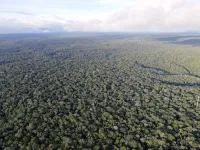(Press-News.org) Three-quarters of Colorado prisons are likely to experience a natural disaster in the coming years, but due to aging infrastructure and outdated policies, many are ill-equipped to keep residents safe, suggests new CU Boulder research.
The study, published in the journal Natural Hazards Review, comes on the heels of one of the hottest summers on record and as U.S. lawmakers are calling for an investigation into a rash of what are believed to be heat-related deaths in the nation’s prisons.
In other research, including interviews and focus groups with 35 formerly incarcerated Coloradans, the researchers found that most had already suffered from climate-related hazards, experiencing everything from “brutally hot” or “ice cold” cells to respiratory problems related to wildfire smoke and lack of toilet facilities during floods.
“We showed that the incarceration infrastructure in Colorado is highly vulnerable to climate- related hazards and that incarcerated people who are Black and Hispanic are at even greater risk,” said Shideh Dashti, associate professor of Civil, Environmental and Architectural Engineering and co-author on both studies. “This is a serious racial justice and environmental justice issue that needs to be addressed.”
Prisoners among the most vulnerable
Researchers have long known that marginalized communities, including people of color, low-income families and people with disabilities, are more vulnerable to climate change. But those behind bars face added risk, as they can’t leave or adapt their space to escape threats.
Facilities tend to be old, with poor insulation and outdated heat, ventilation and air-conditioning systems. Colorado’s oldest prison opened in 1871. About 40% of incarcerated individuals have a mental health diagnosis, and many take medication that impairs their ability to regulate body temperature.
“When coupled with the extreme temperatures, wildfire smoke and floods that climate change brings, these conditions and lack of agency render incarcerated people extremely vulnerable,” said co-author Ben Barron, a doctoral candidate and research assistant in the CU Boulder Department of Geography.
Until recently, little research had been done in this area.
To address the gap, the interdisciplinary research team gathered census data on 110 Colorado facilities, including prisons, jails and juvenile detention and immigration detention centers. They used GIS mapping software and climate modeling data to calculate whether each facility was at low, medium or high risk of wildfire, heatwaves, floods and landslides.
They found that 74.5% of facilities housing 83% of Colorado’s incarcerated population have either moderate or high exposure to at least one hazard, and 17% percent are at risk of two.
One third of facilities, housing about 12,700 people, are at medium to high risk of wildfire.
Fifteen are at risk of flooding while, notably, 26 had no FEMA flood risk data available at all.
About half of facilities are at risk of extreme heat.
The study also found that incarceration facilities are more than twice as vulnerable to flooding than Colorado schools are. That’s relevant, the authors said, because unlike prisoners, students are free to leave when flood risk arises.
Black people are significantly more likely than whites to be jailed in a facility at risk of extreme heat, while Hispanic or Latino people are at greater risk of experiencing a flood while incarcerated, the study found.
‘We’re dying in here’
Dashti said the team had trouble getting information from many facilities about their engineering or architectural elements, but interviews with the formerly incarcerated painted a disturbing picture.
“It’s truly horrifying to listen to,” said Barron, who conducted nine interviews and four focus groups for a separate paper that has not yet been published.
Some interviewees recalled temperatures soaring into the upper-90s inside their cells.
“We just want the doors open because we’re dying in here,’” one told researchers.
When air conditioning was turned on, it was often left on full blast into the cooler months, making it so frigid that ice formed inside cell windows.
Other formerly incarcerated people described being awakened in the night by wildfire smoke and stuffing clothing over vents and windows to keep ash out of their cell. Some had to wait outside in long lines in triple-digit temperatures to get their medications.
“I remember people just burning,” recalled one 46-year-old man, describing his cell mate. “He was out there all day. And he was so purple, and he had edema on his head so bad you could put your thumb in his forehead, and it would just stay.”
‘Cruel and unusual punishment’
Due to lack of emergency planning, prisoners in other states have been infamously left behind when natural disasters hit.
In 2005, during Hurricane Katrina, thousands were locked inside the Orleans Parish Prison for days, submerged in deep, sewage-tainted water and without power. In 2020, during wildfires in California, a wildfire came within a few miles of two state prisons. While neighbors were evacuated, prisoners were left in place.
Colorado prisons have been evacuated at least two times: In 2013, a fire forced evacuation of 900 people from Territorial Correctional Facility in Cañon City. In Barron’s interviews, a person evacuated that day described it as “chaos.” In May 2023, hundreds at the Delta Correctional Center were evacuated due to the threat of flooding.
Dashti said that, as an engineer, she has been horrified to learn of what she equates to “cruel and unusual punishment” in U.S. prisons. She hopes the findings will encourage governments to update building codes and policies to ensure that facilities are more resilient and humane in the face of more frequent and severe natural hazards expected as a result of climate change.
“But we can’t simply engineer out way out of the problem,” she said.
The U.S. has the highest rate of incarceration in the world, imprisoning 700 out of every 100,000 people, compared to 115 out of 100,000 for its peer nations. In Colorado alone, about 31,000 people are currently behind bars.
Dashti, Barron and their interdisciplinary research team believe more support should also be provided for education, mental health care, public housing and other means to keep people from committing crimes or help rehabilitate them when they do.
Some prisons should be closed, they argue.
“It’s not enough to say we’ll just retrofit and add air conditioning,” said Barron. “We need to stop putting so many people in jail.”
Other co-authors on the Natural Hazards Review paper include: Postdoctoral Associate Sara Glade, environmental design student Caleb Schmitz, Environmental Design Associate Professor Shawhin Roudbari, engineering professors Abbie Liel and Shelly Miller, and Phaedra Pezzullo, associate professor in the Department of Communication.
END
Prisons vulnerable to natural disasters, but ill-prepared
A study of 110 Colorado facilities found that 75%, housing 83% of the state's incarcerated population, are at risk of climate-related hazards
2023-10-30
ELSE PRESS RELEASES FROM THIS DATE:
Virtual cognitively enhanced tai chi program improves cognition and executive function in older adults with mild cognitive impairment
2023-10-30
Embargoed for release until 5:00 p.m. ET on Monday 30 October 2023
Annals of Internal Medicine Tip Sheet
@Annalsofim
Below please find summaries of new articles that will be published in the next issue of Annals of Internal Medicine. The summaries are not intended to substitute for the full articles as a source of information. This information is under strict embargo and by taking it into possession, media representatives are committing to the terms of the embargo not only on their own behalf, but also ...
Research Brief: Study uncovers hundred-year lifespans for three freshwater fish species in the Arizona desert
2023-10-30
A recent study found some of the oldest animals in the world living in a place you wouldn’t expect: fishes in the Arizona desert. Researchers found the second genus of animal ever for which three or more species have known lifespans greater than 100 years, which could open the doors to aging studies across disciplines, such as gerontology and senescence (aging) among vertebrates.
The study centers around a series of fish species within the Ictiobus genus, known as buffalofishes. Minnesota has native populations of each of the three species studied: bigmouth buffalo, smallmouth buffalo and black buffalo. The importance of this research is underscored ...
UMaine, UVM researchers conduct first-ever study of cultural adaptation to climate change
2023-10-30
As the impacts of climate change grow, society and people struggle to adapt to the challenges of the new reality. Change, however, is difficult, and adapting to new ways of life or new ways of doing business often requires a change in culture.
To determine how culture and society adapt to a changing climate, a team of researchers from the University of Maine and the University of Vermont (UVM) have conducted the first-ever study of cultural adaptation to climate change. Using the science of cultural evolution to examine data on which crops farmers plant across the U.S., their work can help inspire more effective policy solutions to survive in ...
New frequency comb can identify molecules in 20-nanosecond snapshots
2023-10-30
From monitoring concentrations of greenhouse gases to detecting COVID in the breath, laser systems known as frequency combs can identify specific molecules as simple as carbon dioxide and as complex as monoclonal antibodies with unprecedented accuracy and sensitivity. Amazing as they are, however, frequency combs have been limited in how fast they can capture a high-speed process such as hypersonic propulsion or the folding of proteins into their final three-dimensional shapes.
Now, researchers at the National Institute of Standards ...
Hospital care for children has shifted from general hospitals to children’s hospitals over last 20 years
2023-10-30
CHAPEL HILL, NC – Historically, most children in the United States who needed to be hospitalized were treated at general hospitals that treat both children and adults. But the number of hospitals providing inpatient care for children has decreased over the last decade, and many of them struggled to keep up with the demand for children’s care during a viral infection surge in the fall of 2022.
Now children are much more likely to be treated at children’s hospitals that are concentrated into fewer locations, according to a new study led by UNC School of Medicine researchers.
“The ...
The brain may learn about the world the same way some computational models do
2023-10-30
CAMBRIDGE, MA -- To make our way through the world, our brain must develop an intuitive understanding of the physical world around us, which we then use to interpret sensory information coming into the brain.
How does the brain develop that intuitive understanding? Many scientists believe that it may use a process similar to what’s known as “self-supervised learning.” This type of machine learning, originally developed as a way to create more efficient models for computer vision, allows computational models to learn about visual scenes based solely on the similarities and differences between them, with no ...
Largest brain autopsy study of female intimate partner violence decedents reveals brain injury pathology unlike that seen among male contact sports athletes
2023-10-30
The largest brain autopsy study of women who had experienced intimate partner violence reveals substantial vascular and white matter damage in the brain, but no evidence of chronic traumatic encephalopathy (CTE), the neurodegenerative disease recognized among male contact sports athletes who sustain repeated head trauma.
The international collaboration, led by a team from the Brain Injury Research Center of Mount Sinai in collaboration with the New York City Office of the Chief Medical Examiner, appears in the most recent issue of Acta Neuropathologica.
Importantly, ...
Soy expansion in Brazil linked to increase in childhood leukemia deaths
2023-10-30
URBANA, Ill. – Over the past decades, Brazil has become the world’s leading soybean producer, as well as the leading consumer of pesticides. Despite concerns about potential public health consequences, little is known about the effects of pesticide exposure in the general population. A new study from the University of Illinois Urbana-Champaign in collaboration with the University of Denver and University of Wisconsin-Madison looks at how soy expansion and increased pesticide use in Brazil’s Cerrado and Amazon biomes correlate with increased childhood cancer mortality.
“The Brazilian Amazon region is undergoing a transition ...
Amazon deforestation linked to long distance climate warming
2023-10-30
Deforestation in the Amazon causes land surfaces up to 100 kilometres away to get warmer, according to a new study.
The research, by a team of British and Brazilian scientists, led by Dr Edward Butt at the University of Leeds, suggests that tropical forests play a critical role in cooling the land surface - and that effect can play out over considerable distances.
It is known that when tropical forests are cleared, the climate in the immediate vicinity gets warmer.
In this latest study, the researchers wanted to know if deforestation in the Amazon was resulting in climate warming further afield, and the study examined the impact of forest loss on sites up to ...
NYU Abu Dhabi researchers reveal how common desert shrub efficiently harvests water from the air
2023-10-30
Abu Dhabi, UAE, October 2023: A team of scientists, led by Post-Doctoral Associate Marieh Al-Handawi and Professor of Chemistry Panče Naumov from NYU Abu Dhabi’s Smart Materials Lab and NYU Abu Dhabi Institute’s Center for Smart Engineering Materials (CSEM) has revealed the mechanism a desert plant native to the United Arab Emirates uses to capture moisture from the desert air in order to survive. The identification of this unique mechanism, in which the plant excretes salts to extract and condense water onto the surface of its leaves, has the potential to inspire ...
LAST 30 PRESS RELEASES:
Ticking time bomb: Some farmers report as many as 70 tick encounters over a 6-month period
Turning garden and crop waste into plastics
Scientists discover ‘platypus galaxies’ in the early universe
Seeing thyroid cancer in a new light: when AI meets label-free imaging in the operating room
Neutrophil-to-lymphocyte ratio may aid risk stratification in depressive disorder
2026 Seismological Society of America Annual Meeting
AI-powered ECG analysis offers promising path for early detection of chronic obstructive pulmonary disease, says Mount Sinai researchers
GIMM uncovers flaws in lab-grown heart cells and paves the way for improved treatments
Cracking the evolutionary code of sleep
Medications could help the aging brain cope with surgery, memory impairment
Back pain linked to worse sleep years later in men over 65, according to study
CDC urges ‘shared decision-making’ on some childhood vaccines; many unclear about what that means
New research finds that an ‘equal treatment’ approach to economic opportunity advertising can backfire
Researchers create shape-shifting, self-navigating microparticles
Science army mobilizes to map US soil microbiome
Researchers develop new tools to turn grain crops into biosensors
Do supervised consumption sites bring increased crime? Study suggests that’s a myth
New mass spec innovation could transform research
Maternal nativity, race, and ethnicity and infant mortality in the US
Migration-related trauma among asylum seekers exposed to the migrant protection protocols
Jupiter’s moon Europa has a seafloor that may be quiet and lifeless
SwRI upgrades nuclear magnetic resonance laboratory for pharmaceutical R&D
House sparrows in northern Norway can help us save other endangered animals
Crohn's & Colitis Foundation survey reveals more than 1/3 of young adults with IBD face step therapy insurance barriers
Tethered UAV autonomous knotting on environmental structures for transport
Decentralized social media platforms unlock authentic consumer feedback
American Pediatric Society announces Vanderbilt University School of Medicine as host institution for APS Howland Visiting Professor Program
Scientists discover first method to safely back up quantum information
A role for orange pigments in birds and human redheads
Pathways to net-zero greenhouse gas emissions for Southeast Asia
[Press-News.org] Prisons vulnerable to natural disasters, but ill-preparedA study of 110 Colorado facilities found that 75%, housing 83% of the state's incarcerated population, are at risk of climate-related hazards




